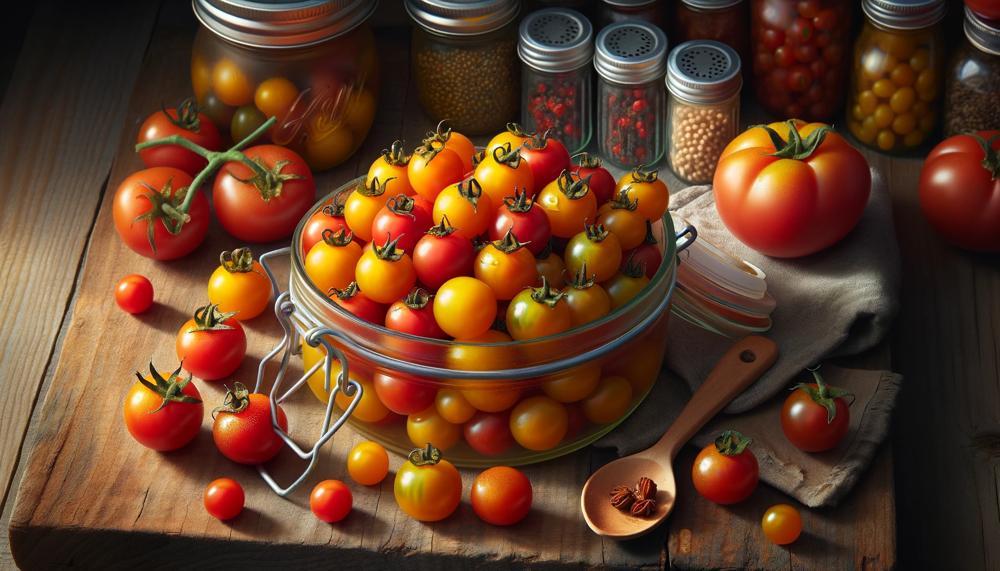Grape tomatoes are a popular choice for their sweet and vibrant flavor. Whether you’re using them in salads, pasta dishes, or roasted creations, knowing their shelf life and how to maximize their freshness is essential.
At room temperature, grape tomatoes typically last about 1 week. To ensure optimal freshness, store them in a cool area away from direct sunlight. Refrigeration is not necessary unless you need to extend their shelf life. When refrigerated, grape tomatoes can last up to 5 days, although it may slightly affect their flavor.
Handling grape tomatoes gently is crucial to avoid bruising. Avoid squeezing them and handle them by their sides or bottoms instead. Additionally, storing them away from ethylene-producing fruits like apples and bananas can prevent accelerated ripening and spoilage.
Contents
Key Takeaways:
- Grape tomatoes have a shelf life of about 1 week at room temperature.
- Refrigeration can extend their shelf life up to 5 days, but it may slightly affect their flavor.
- Store grape tomatoes in a cool area away from direct sunlight to maximize freshness.
- Handle grape tomatoes gently to avoid bruising.
- Avoid storing grape tomatoes near ethylene-producing fruits to prevent accelerated ripening.
How Long Do Grape Tomatoes Last?

Grape tomatoes can last for different amounts of time depending on how they are stored:
- Unopened at room temperature: Grape tomatoes can last for 1–2 weeks if stored at room temperature.
- In the fridge: Unripe grape tomatoes can be left out at room temperature, away from direct sunlight. Ripe grape tomatoes can be stored in the fridge to retain their freshness for a few days to a week.
- In the freezer: To freeze tomatoes, remove the cores and place the tomatoes in an air-tight freezer bag. Tomatoes will typically last up to 6–8 months in the freezer.
Tomatoes can also be stored at 45–60 °F with a relative humidity of 95% for up to 10 days. Tomatoes stored at refrigeration temperatures below 41 °F will have a shelf life of about 5 days.
Some say that storing fruits and vegetables at the temperature they are sold at is best. They also say that tomatoes lose their flavor and aroma when stored in the fridge.
Tips for Maximizing Freshness of Grape Tomatoes
When it comes to grape tomatoes, maximizing freshness is key to enjoying their vibrant flavor and texture. Here are some expert tips to ensure your grape tomatoes stay fresh for as long as possible:
- Store at room temperature: Keep your grape tomatoes in a cool, dark place away from direct sunlight. This will help preserve their freshness and prevent them from becoming overripe.
- Avoid refrigeration: While refrigeration can extend the shelf life of grape tomatoes, it can also slightly affect their flavor. Unless you need to prolong their freshness, it’s best to leave them at room temperature.
- Handle with care: Grape tomatoes are delicate and prone to bruising. Always handle them gently to avoid damage. Rather than squeezing them, handle them by their sides or bottoms.
- Avoid ethylene-producing fruits: Keep grape tomatoes away from ethylene-producing fruits like apples and bananas. Ethylene is a natural ripening agent that can accelerate spoilage and lead to premature ripening of the tomatoes.
- Check for signs of spoilage: Before storing your grape tomatoes, check for any signs of mold or overripe spots. Dispose of any damaged or spoiled tomatoes as they can affect the freshness of the remaining ones.
By following these simple storage and handling tips, you can maximize the freshness of your grape tomatoes and enjoy their sweet, juicy flavor to the fullest.
| Storage Tips | Handling Tips |
|---|---|
| Store at room temperature | Handle with care |
| Avoid refrigeration | Avoid squeezing |
| Avoid ethylene-producing fruits | Handle by sides or bottoms |
| Check for signs of spoilage |
Different Uses for Grape Tomatoes
Grape tomatoes are a versatile ingredient that can elevate the flavor and visual appeal of your dishes. Whether you’re looking to add a burst of color to your salads or enhance the taste of your pasta, grape tomatoes can be a delicious addition to your culinary creations. Here are some recipe ideas and culinary uses for cooking with grape tomatoes:
1. Salads
Add a pop of color and a burst of juicy flavor by incorporating grape tomatoes into your salads. Their vibrant hue and sweet taste can complement a variety of greens, making your salad not only visually appealing but also delicious.
2. Pasta Dishes
Grape tomatoes can bring a fresh and vibrant addition to your pasta dishes. Whether you’re preparing a classic tomato sauce or a light pasta salad, the sweet and tangy flavors of grape tomatoes can elevate your pasta to new levels of taste.
3. Roasting
Roasting grape tomatoes with garlic, salt, and olive oil can intensify their natural sweetness, unlocking a whole new depth of flavor. The caramelization process creates a rich and savory taste, making roasted grape tomatoes perfect for sauces, pizzas, and pasta dishes.
4. Lengthwise Slicing
When using grape tomatoes in salads or as a garnish, try slicing them lengthwise instead of across the middle. This technique helps retain their juicy texture and enhances the presentation of your dishes.
5. Sautéing
Sautéing grape tomatoes can enhance their natural sweetness and bring out their flavors. Heat a pan with some olive oil, add the tomatoes, and cook them until slightly softened. The heat intensifies their taste, making them a delightful addition to various recipes.
Get creative with these culinary uses and recipe ideas for cooking with grape tomatoes. Experiment with different flavors and ingredient combinations to create delicious dishes that showcase the versatility of these tiny, flavorful fruits.
Can You Substitute Grape Tomatoes for Cherry Tomatoes?
Yes, grape tomatoes can be substituted for cherry tomatoes in most recipes. They have a similar size and flavor profile, making them interchangeable ingredients in your culinary creations. However, it’s important to note that there are slight differences in texture and juiciness between the two.
When substituting grape tomatoes for cherry tomatoes, it’s crucial to consider the cooking method and adjust the cooking time accordingly. The slight differences in texture and juiciness may affect the outcome of the dish, so it’s important to be mindful of these factors. The substitution works best in recipes where the tomatoes are cooked or incorporated into a dish rather than served raw, as this allows for any variations in texture to be mitigated.
Do Grape Tomatoes Need to be Peeled Before Cooking?
In the culinary world, grape tomatoes are known for their vibrant flavor and juicy texture. One common question that arises when cooking with grape tomatoes is whether or not they need to be peeled. The answer is simple – no. Grape tomatoes do not need to be peeled before cooking.
Unlike other tomatoes with thicker skins, grape tomatoes have a thin and delicate skin that is not only edible but also adds to the overall texture and flavor of the dish. The skin helps to hold the tomato’s shape and juiciness during cooking, making it perfect for various culinary uses.
When incorporating grape tomatoes into your cooking, there is no need to go through the hassle of peeling them. Simply wash them thoroughly to remove any dirt or debris, and they are ready to be used in your favorite recipes. The skin adds a pleasant chewiness to dishes and enhances the overall eating experience.
However, if you prefer a smoother texture, it is possible to remove the skin after cooking. You can achieve this by blending the cooked grape tomatoes or passing them through a strainer to remove any seeds or skin. This technique is particularly useful when making sauces or soups that require a smoother consistency.
Benefits of Cooking with Grape Tomatoes
When cooking with grape tomatoes, their small size and bold flavor can elevate your dishes in various ways. Here are a few culinary uses for grape tomatoes:
- Add them to salads for a burst of color and a juicy bite.
- Roast them with olive oil, garlic, and herbs to bring out their natural sweetness and intensify their flavor.
- Use them in pasta dishes for a fresh and vibrant addition.
- Make a quick and delicious salsa by chopping grape tomatoes, onions, jalapenos, and cilantro.
- Incorporate them into bruschetta for a flavorful topping on toasted bread.
Grape tomatoes offer greater versatility in cooking as their small size allows for quick cooking and even distribution of flavors in dishes.
| Culinary Uses | Benefits |
|---|---|
| Salads | Provides a burst of color and juicy texture |
| Pasta dishes | Brings freshness and vibrancy to the dish |
| Roasted dishes | Enhances natural sweetness and intensifies flavor |
| Salsas and bruschetta | Adds bold flavor to these popular appetizers |
Conclusion
Grape tomatoes are a versatile ingredient that can add a burst of color and flavor to various dishes. Their shelf life can be maximized by following a few freshness tips. Storing grape tomatoes at room temperature in a cool area away from direct sunlight is recommended. Refrigeration is not necessary unless you need to extend their shelf life. Remember to handle them gently to avoid bruising and store them away from ethylene-producing fruits.
By following these freshness tips, you can enjoy the sweet and vibrant taste of grape tomatoes in your culinary creations. Whether you use them in salads, pasta dishes, or roasted for sauces, their juicy texture and rich flavor will elevate your meals. The thin, edible skin of grape tomatoes adds to the overall taste and can be used without peeling. So go ahead and experiment with these versatile tomatoes to bring freshness and color to your recipes.
With their 1-week shelf life at room temperature, grape tomatoes are a convenient ingredient to keep on hand. Their small size and sweet taste make them a popular choice for cooking and snacking. Remember to check for signs of mold or overripe spots before storage, and enjoy their freshness while they last. Incorporate grape tomatoes into your next meal and savor the bright and tangy flavors they bring to the table.
Source Links
- https://cooklist.com/products/produce/fresh-vegetables/grape-tomato
- https://www.cde.state.co.us/nutrition/osnffvpproduceinfosheetscherrytomatoes




